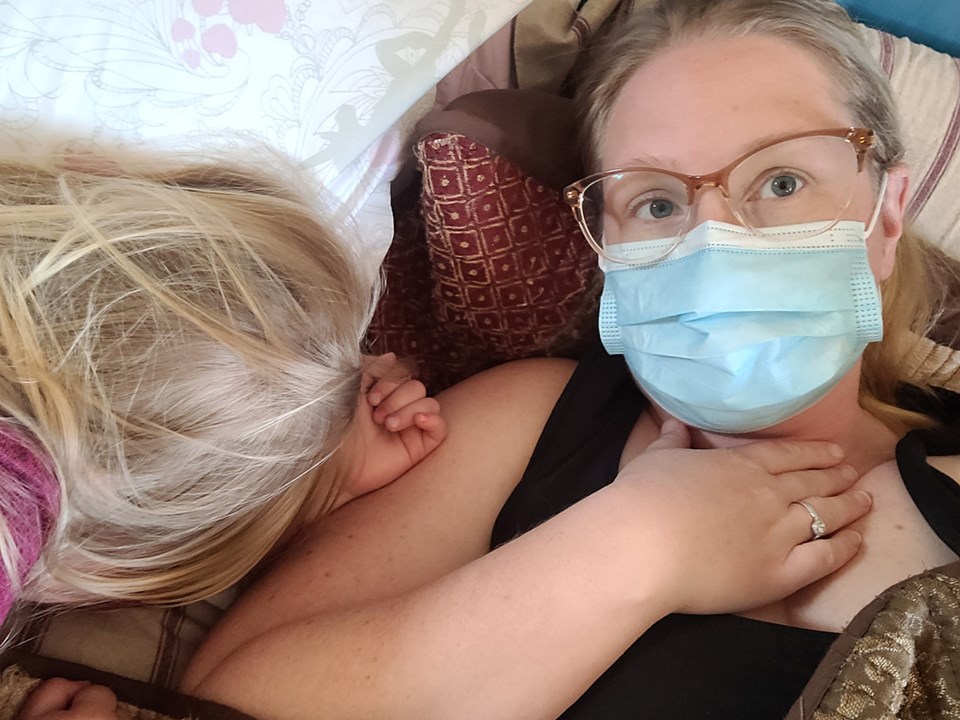A candid interview with Jenn Sedor shed light in wonder of what it might be like to contract the COVID-19 virus or any of its variants.
Sedor, Carlyle’s mayor, was very transparent as she detailed her family’s ordeal with the B117 U.K. variant of the virus as she said early in the interview, “You cannot safely judge the health of someone else by looking at them, and you definitely cannot keep six feet away from a toddler.”
The Sedor family had a niece come and stay with grandma and grandpa, who found out days later that the niece had a confirmed COVID child in her class back home. This began the barrage of phone calls, isolation and testing of which the youngest Sedor was the only one out of the five in the family who tested positive.
Even though, Tim, Jenn, Lily and Tayo tested negative, Jenn volunteered to isolate in a room in the house, just June and her.
Although June tested positive, her symptoms were none other than the occasional sneeze and a bit of a runny nose, “Nothing that any parent would even think was odd for every day in a toddler’s life,” Jenn Sedor said.
Three days into their isolation, Tim’s regular temperature check showed a fever.
One tool Jenn said was a godsend is called a pulse oximeter. Pulse oximetry is a method of monitoring a person’s blood oxygen levels without the invasiveness of arterial blood gas analysis, and it can be done at home.
With Tim’s rising temperature, he was tested again, and this time had a positive result. “Things happened so quickly from there. The pulse oximeter showed a quickly dropping oxygen level and the virus quickly attacked his lungs. It wasn’t long before they were treating him for pneumonia.”
The picture Jenn painted of the situation was strained. The continual calling to Redvers Hospital for reporting, for help, for advice, and then having the entire staff of health care professionals weigh the dangers of having them come to the hospital and spread infection, or stay home and continue to get increasingly sick. How sick do you let people get?
“You don’t just get to say ‘Hmm, I feel sick so I will run to the doctor or hospital and get things checked out’. There are so many factors at play. There is just so much that we don’t know,” Jenn said with a tremble in her voice as she recalled the severe suffering and death of some.
“I know people are saying it is just a flu/cold so I will risk it. Well, I am telling you this didn’t feel like any other illness we have ever had. It came on so fast and hit so hard. The symptoms were the weirdest and most painful we have ever had, and they continued to come and go for days.”
Jenn explained that days seven to 14 of isolation were the worst for her.
“I was fine and looking after everyone and then my body did a 180. I could not get out of bed. I was so tired and in so much pain. It hurt to breathe.”
The Sedors spent a full 30 days in isolation. During this time, Jenn was testing positive and negative for the virus and Lily and Tayo never did test positive but got very sick. Their symptoms included extreme fatigue, pain, difficulty breathing, brain fog, insomnia and anxiety. Today, they are having complications/side effects show up every day such as nose bleeds, bronchitis, blood clotting, fatigue, pneumonia and problems with other bodily functions that come and go. COVID-19 is a full systemic infection and will affect everyone differently.
The entire family has been advised that they may have long lasting comorbidities and permanent damage to their bodies’ systems. If they contract a different strain, will it be worse next time? No one can say but one thing is certain, their immune systems are weak.
“I don’t want to scare people with the facts of our story, but I do want people to know what we experienced so they can make informed decisions. Our real new normal is mitigating risk,” Sedor said as she gave a big sigh. “We are all tired. Tired of COVID restrictions and rules and information. We just want to live our lives. I last saw my mom from Manitoba during Christmas 2019.”
Sedor didn’t stop there as she explained the tragedy that Carlyle and all small Saskatchewan towns will experience if this hits a large portion of our population. “We are not like Regina where there are numerous businesses and thousands of people to keep going. Picture isolating large groups in Carlyle. These new strains are attacking young people. I would hate to see businesses close down with many people, young and older, getting sick all at once. We cannot give up.”
What is it we cannot give up? Don’t give up hope that all our masks and hand sanitizer are making a difference. Don’t give up on the health authorities as they work hard to collect and communicate their findings. Don’t give up on each other. If you can avoid the virus, do it. If you are healthy enough to get vaccinated, it seems like a simple solution with what we currently know.
“I would rather have the vaccine and its effects than experiencing that again,” Jenn exclaimed.
Tim and Jenn and the entire family will be forever grateful for those who came alongside them at this time. The Redvers Hospital staff were caring, compassionate and willing to take them in.
“They apologized 100 times when they couldn’t just take Tim in right away because of safety reasons,” she remembered. The family would like to thank their friends and neighbours for doing their errands and bringing them food.
“We are so thankful to live in such a caring community.”



